Journal Club: The birds and the trees
Hoarding and breeding strategy of the Gray Jay
SUMMARY: Gray jays hoping to survive and reproduce during Canada’s harsh winters must store food in the right kinds of trees
![]() If you’ve ever met a gray jay, Perisoreus canadensis, then I think you’ll agree with me that this audacious and personable bird is one of the cutest corvids in the world. Like many corvids, these little birds invest most of their waking hours into preparing for a “rainy day” by seeking out and collecting food. But gray jays experience more than the occasional rainy day: they are year-round residents of boreal and subalpine coniferous forests in North America, so they regularly deal with cold temperatures, high winds and deep snows that blanket their food supply for long periods of time.
If you’ve ever met a gray jay, Perisoreus canadensis, then I think you’ll agree with me that this audacious and personable bird is one of the cutest corvids in the world. Like many corvids, these little birds invest most of their waking hours into preparing for a “rainy day” by seeking out and collecting food. But gray jays experience more than the occasional rainy day: they are year-round residents of boreal and subalpine coniferous forests in North America, so they regularly deal with cold temperatures, high winds and deep snows that blanket their food supply for long periods of time.
Gray jays are omnivorous, consuming (and caching) berries, insects, titbits of meat from carcasses along with a variety of food items stolen from campsites. But there is one item that is notably absent from gray jays’ daily menus; conifer seeds. In fact, these birds are neither capable of prying open nor extricating seeds from conifer cones. Further, gray jay population numbers do not fluctuate with the availability of seeds as is typical for conifer seed predators. Why are gray jays so intimately associated with coniferous forests when they don’t consume their seeds?
Another interesting element to note is that gray jays cache perishable food items into cracks in tree bark during the summer and autumn months. In fact, gray jays are the only bird species that we know about that routinely cache large amounts of perishable food items for long periods of time. How do these food items survive the warm summer months until the freezing temperatures of winter, when the birds consume their caches? Contrary to what you might expect; these birds are not merely caching food so they can survive harsh winters: gray jays nest and raise their chicks in the dead of winter, too.
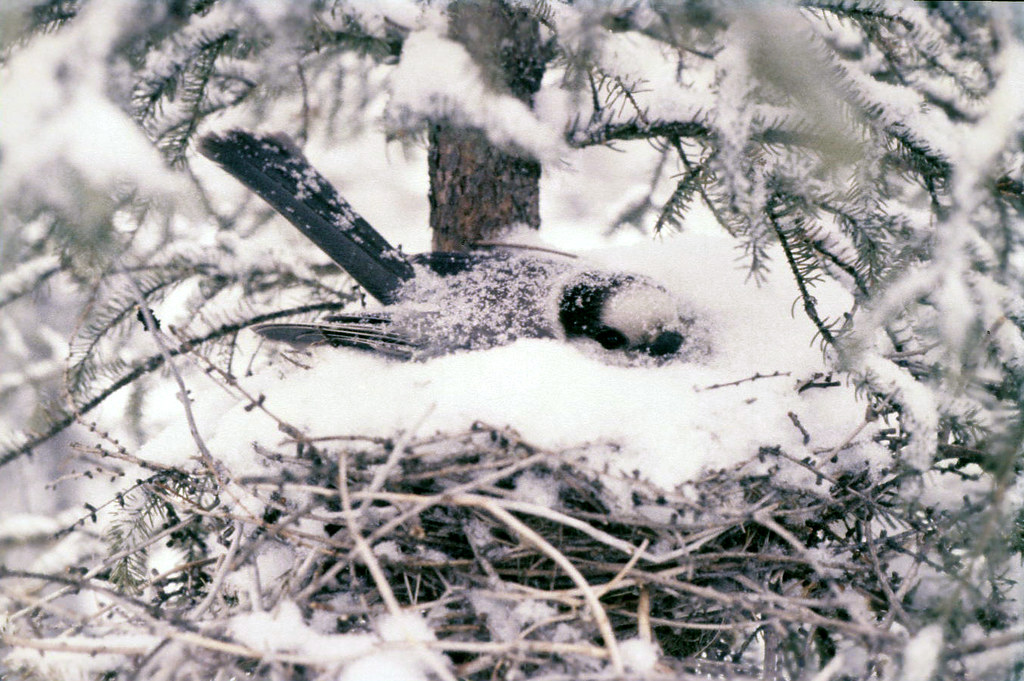
Gray jay, Perisoreus canadensis, nesting in Algonquin Park, Canada.
Image: Dan Strickland (with permission) [Velociraptorise].
“What is perhaps more remarkable is that female gray jays start breeding in mid-February when temperatures are routinely below minus 15 degrees Celsius and there is very little food around, so these caches are crucial not only for over-winter survival but also for successful reproduction,” says Ryan Norris, a professor in the Department of Integrative Biology at the University of Guelph, in Ontario, Canada.
Several years ago, Dr Norris began working with Dan Strickland, retired chief park naturalist for Algonquin Park. Even though it wasn’t part of his job, for decades Mr Strickland devoted his spare time to studying the park’s jays; colour banding the birds in autumn and monitoring their nests and chicks in late winter. The birds became like family.
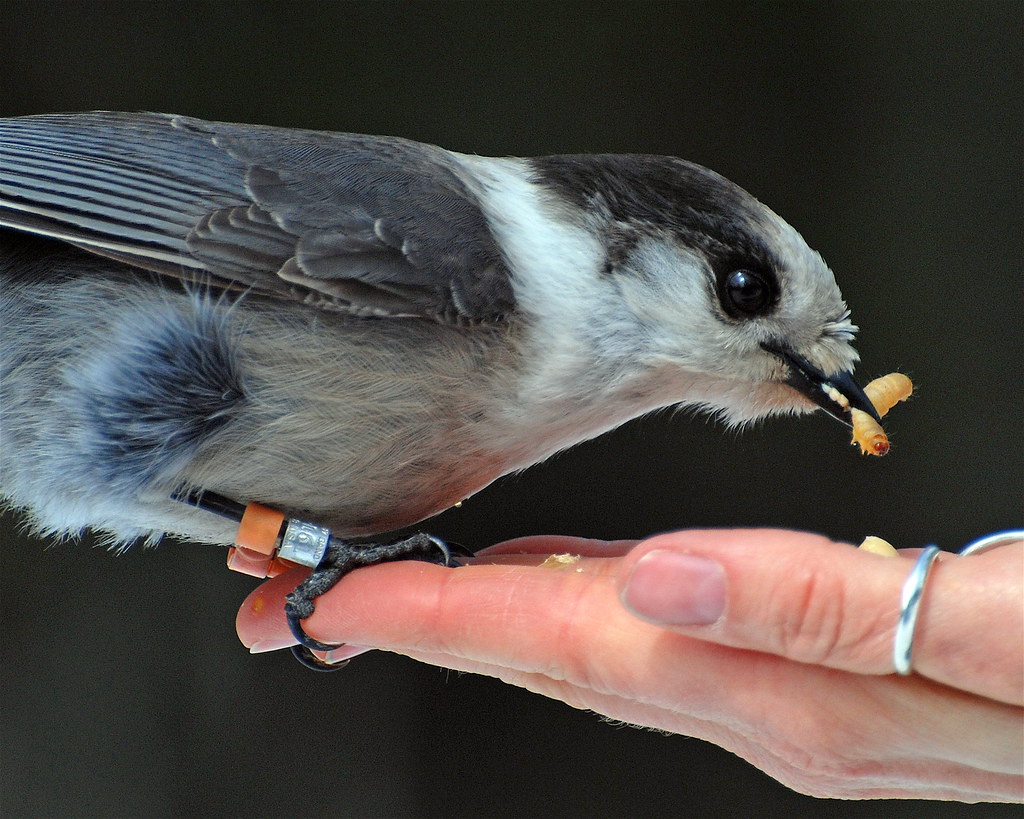
Gray jay, Perisoreus canadensis, dining on a mealworm. Notice the colour bands on both the bird’s legs. Each individual has a unique combination of colour bands.
Image: Kelly Dodge (with permission) Nikon D80 [velociraptorise].
Algonquin Park is located at the most southern portion of the gray jays’ natural range in the eastern part of North America. However, Mr Strickland had noticed that the gray jay population in Algonquin Park had declined noticeably since the 1970s.
“When Dan and I do field research, Dan is always pointing out areas where jays used to be but haven’t been used [as territories] for decades,” says Dr Norris in email.
“This puzzled us. Not only were jays declining in the park but they were declining in certain types of habitats. It follows that these habitats must be of lower quality than the ones that are still occupied. But why?”
This is where University of Guelph geography undergrad, Brian Kielstra, came into the picture. His undergrad thesis consisted of identifying specifically what constituted high and low quality habitats for the jays. To do this, he used GIS to link habitat composition of gray jay territories to their occupancy rate over time (figure 2):

Mr Kielstra’s data show that gray jays abandoned territories with lower proportions of conifers and they abandoned those territories at faster rates over time.
But what is it about the presence of a large percentage of conifer trees that made the jays remain on their territories? Knowing that the birds nested during the harshest weather of the year, the team tested whether the proportion of conifer trees in a particular territory had an effect on the residents’ nest success (figure 3):
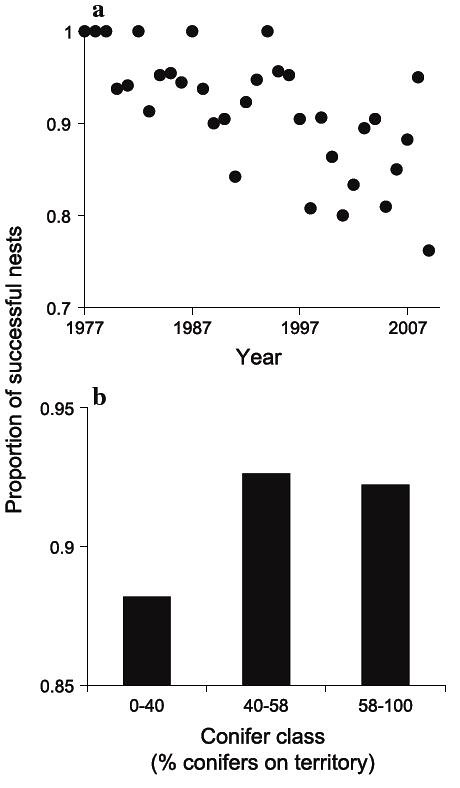
They found that the proportion of successful gray jay nests was related to both the year (1977–2009) when the birds nested (figure 2a) and to the percentage of conifers in their territory (figure 2b).
But why are gray jays so dependent upon coniferous trees? The team did some brainstorming and identified several testable hypotheses. Knowing that these birds are so critically dependent upon their food caches, the most obvious hypothesis was that conifer trees are linked to the jays’ ability to successfully cache adequate amounts of food for winter. But what is it about coniferous trees that makes them so important for jay food caches? Is it just coniferous trees in general, or are some coniferous species more important than others? Knowing these answers could provide the team with more clues.
Previous research had shown that most conifer trees defend themselves from the nibbling attentions of herbivores, particularly hares and deer, by growing thick bark and by producing toxic resins.
Knowing that useful food storage sites are dependent upon the physical characteristics of both birds and bark was an important consideration. For example, even though balsam fir, aspens, and young white pine are present in the gray jays’ territories, their smooth-barked trunks and branches provide the jays few food storage opportunities. In contrast, sugar maple and older white pine have rough bark but their surfaces are so tough that a little bird with a small beak would not be physically capable of prying up the bark to hide a morsel of food underneath.
But what about spruce trees? The team realised that spruce could be indicators of territory quality: their data seemed to suggest that higher quality gray jay territory had a greater proportion of black and white spruce, Picea mariana and P. glauca. Additionally, spruce produce toxic resins that could act as a food preservative. Further, spruce growing in the resource-limited boreal (where gray jays are more numerous) produce more toxic resins than do more spruce growing at more southerly locations, such as Algonquin Park. Perhaps the jays were relying upon toxic spruce resins as a preservative for their cached food?
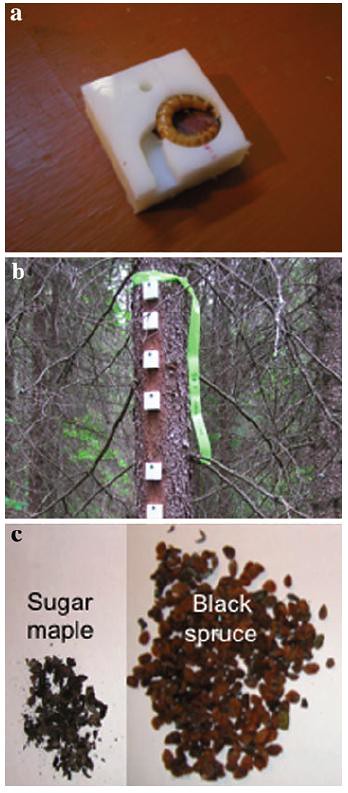 “Jays cache tens of thousands of food items a year and rely on this cached food for overwinter survival and even reproduction”, says Dr Norris. “To test this hypothesis, we set out simulated cache containers on different tree species.”
“Jays cache tens of thousands of food items a year and rely on this cached food for overwinter survival and even reproduction”, says Dr Norris. “To test this hypothesis, we set out simulated cache containers on different tree species.”
The team constructed artificial storage chambers of polyethylene so the food items were stored between an inner layer and outer layer of bark, mimicking gray jay food caches. Raisins were placed into the well (figure a — well, that’s a mealworm, but you get the idea), a piece of bark placed on top and the chambers were attached to the surface of the tree of the same species (figure b), creating a “bark sandwich”. (Controls contained the same food items in chambers with no bark disk and were mounted on trees near the black spruce site.) After the team went back to recover their cached raisins, those stored on spruce trees appeared relatively intact compared to unidentifiable small black fragments that were recovered from those stored on sugar maple (figure c). (Presumably, neither Dr Norris nor Mr Strickland subjected the spruce-cached raisins to a taste test.)
The team then repeated their experiment, expanding it to include black spruce, white spruce, red pine, white pine, eastern white cedar, aspen spp. (either trembling or largetooth), sugar maple, balsam fir, and white birch. They created 100 “bark sandwiches” for each tree species, each containing cached raisins, commercially grown blueberries or jumbo-sized mealworms that had been killed by crushing their heads with tweezers and placing these chambers on a number of tree species (figure 4):
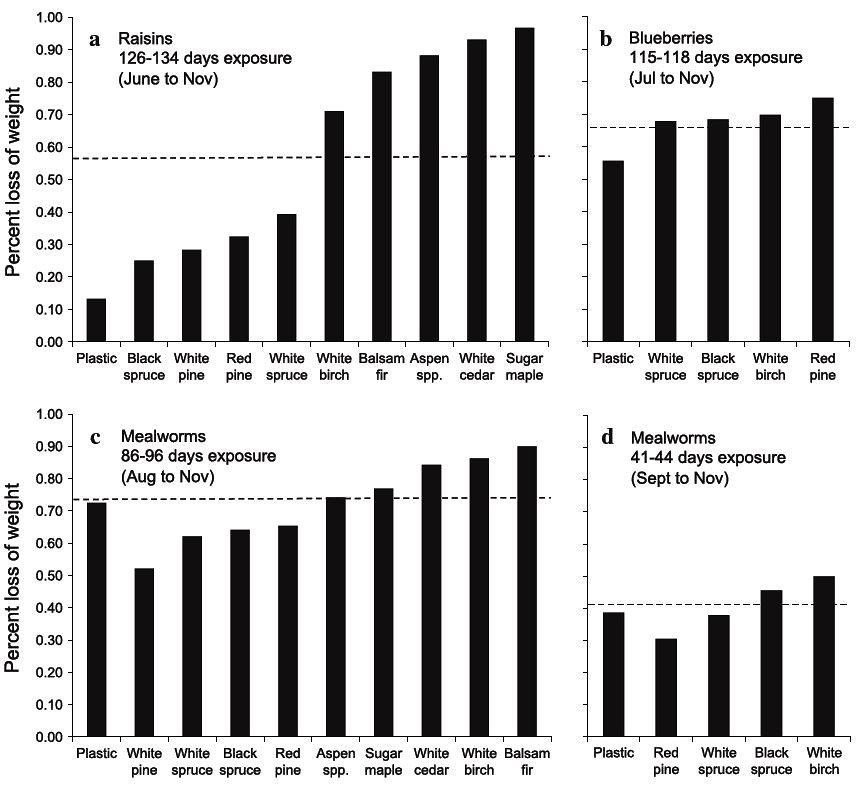
Later, they went back to recover the cached food items and weighed them to identify which tree species was best at preserving them.
“Consistent with the hypothesis, we found that coniferous trees were much better at preserving cached food”, says Dr Norris.
The team found that the proportion of original weight lost by the food items varied depending both upon the species of trees they were stored on and the length of time stored: spruce showed the least percentage of weight loss for most items stored (here’s a larger view of these data shown above).
Different cached food items also showed differences in weight loss. As you can see in the above figure, weight loss was highest in blueberries after 115–188 days of exposure, lower in raisins after 126–134 days of exposure, and lowest in mealworms after 41–44 days of exposure. These data clearly show that different trees are better at storing food for long periods of time.
“Many northern breeding animals rely on cached food for overwinter survival”, says Dr Norris. “What this study shows is that the type of habitat where you store your food can have a large effect on whether it is there 3-4 months later when you really need it.”
The team also saw differences in the jays’ reproductive success between habitats: lower quality habitat meant they were less successful at fledging young.
Previous research indicates that warmer autumn temperatures associated with global warming could result in increased rotting of the jays’ food stores (doi:10.1098/rspb.2006.3667). Low-quality food could compromise the physical condition of the adult birds during the winter and also reduce their ability to adequately feed their hungry nestlings.
“At the moment, we only have correlation evidence to support this hypotheses”, explains Dr Norris. “We are currently conducting an experiment to examine the effect of temperature on food in simulated caches. We’ve put these simulated caches out at different latitudes, including a lower latitude where Jays are not found but [which] has temperatures that could be in Algonquin in 20-30 years from now.”
This study could help scientists better understand range limits for other animals, particularly for other animals that breed in areas with extreme weather conditions.
“If other northern-breeding or alpine-breeding species rely on cached food, then their ranges may also be limited by the ability of certain habitat types to preserve food over the winter season.”
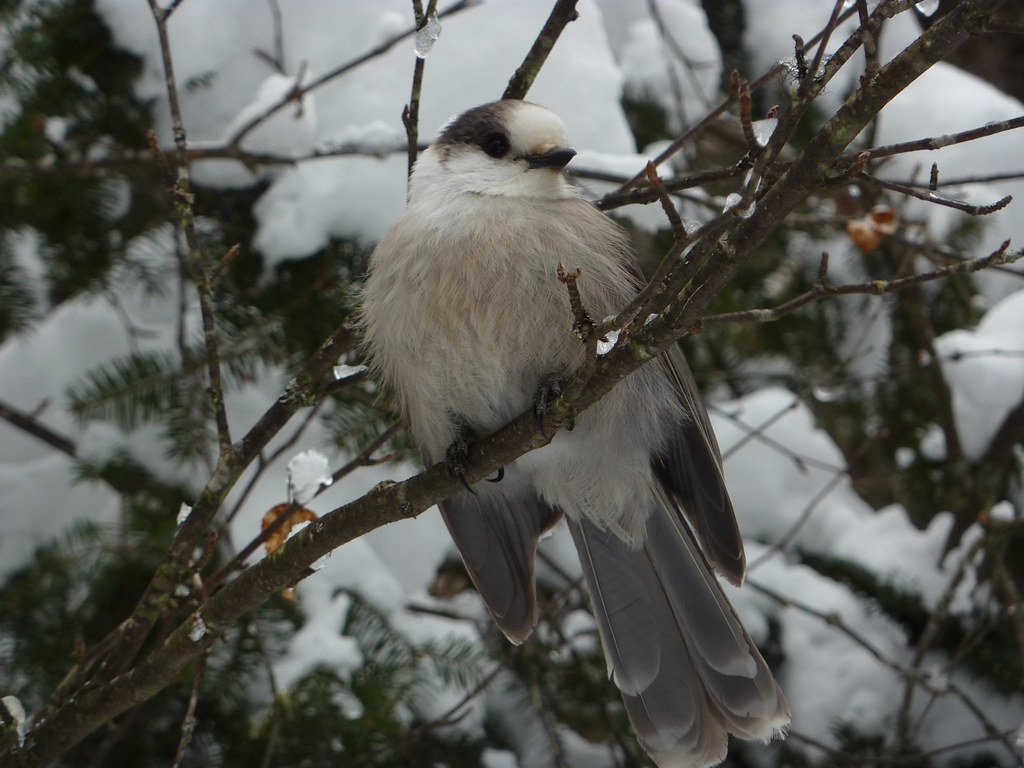
Gray jay, Perisoreus canadensis, sits in one of his conifer trees in Algonquin Park, Canada.
Image: Ryan Norris (with permission) Panasonic DMC-ZS1 [Velociraptorise].
Sources:
Strickland, D., Kielstra, B., & Ryan Norris, D. (2011). Experimental evidence for a novel mechanism driving variation in habitat quality in a food-caching bird. Oecologia DOI: 10.1007/s00442-011-2040-y
Ryan Norris [emails; 11 & 12 October 2011]
.. .. .. .. .. .. .. .. .. .. .. ..
twitter: @GrrlScientist
facebook: grrlscientist
email: grrlscientist@gmail.com
NOTE: this story was originally published here.
A pair of gray jays, Perisoreus canadensis, sits in one of their conifer trees in Algonquin Park, Canada. Photo: Ryan Norris (with permission) Olympus C750UZ.
age:

Fascinating stuff and stunning photos!
Great post and lovely photos of the Gray Jay!